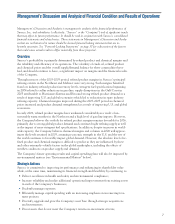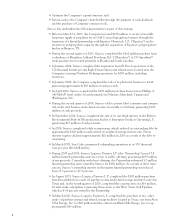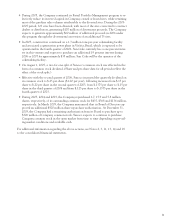Sunoco 2005 Annual Report Download - page 19
Download and view the complete annual report
Please find page 19 of the 2005 Sunoco annual report below. You can navigate through the pages in the report by either clicking on the pages listed below, or by using the keyword search tool below to find specific information within the annual report.until the investors recover their investments and achieve a cumulative annual after-tax
return that averages approximately 10 percent. Expense is recognized to reflect the invest-
ors’ preferential returns. Such expense, which is included in Net Financing Expenses and
Other under Corporate and Other in the Earnings Profile of Sunoco Businesses, totaled
$27, $31 and $36 million after tax in 2005, 2004 and 2003, respectively.
Income is recognized by the Coke business as coke production and sales generate cash
flows and tax benefits, which are allocated to Sunoco and the third-party investors. The
Coke business’ after-tax income attributable to the tax benefits, which primarily consist of
nonconventional fuel credits, was $38, $35 and $38 million after tax in 2005, 2004 and
2003, respectively. Under preexisting tax law, the coke production at Jewell and Indiana
Harbor would not be eligible to generate nonconventional fuel tax credits after 2007,
which is expected to result in a decline in Coke’s annual income of approximately $12 mil-
lion on an after-tax basis beginning in 2008. The energy policy legislation enacted in Au-
gust 2005 includes additional tax credits pertaining to a portion of the coke production at
Jewell, all of the production at Haverhill and all future domestic coke plants placed into
service by January 1, 2010. The new credits cover a four-year period, effective January 1,
2006 or the date any new facility is placed into service, if later. Beginning in 2006, the new
credits attributable to Coke’s existing Jewell and Haverhill facilities are expected to result
in an increase in Coke’s annual income of approximately $6 million after tax. However,
prior to their expiration dates, all of the tax credits would be phased out, on a ratable basis,
if the average annual price of domestic crude oil at the wellhead is within a certain
inflation-adjusted price range. (This range was $51.35 to $64.47 per barrel for 2004, the
latest year for which the range is available.) The domestic wellhead price averaged $50.26
per barrel for the year ended December 31, 2005. If this annual crude oil price averages at
or above the top of the inflation-adjusted range during 2006 or 2007, then it is estimated
the corresponding reduction in Coke’s after-tax income would approximate $24 million for
each year. The above estimates incorporate increased coke prices resulting from the
expiration or any phase out of the tax credits with respect to coke sold under long-term
contracts from the Indiana Harbor and Haverhill plants. The Company also could be re-
quired to make cash payments to the third-party investors if the tax credit is reduced as a
result of increased domestic crude oil prices. However, the Company currently does not
believe that any such payments would be required. (See Note 13 to the consolidated
financial statements.)
The preferential return period for the Jewell operation is projected to end during 2011,
while the preferential return period for the Indiana Harbor operation is projected to end
during 2007. Due to the difficulty of forecasting operations and tax benefits into the future,
the accuracy of these estimates is subject to considerable uncertainty. The estimated
lengths of these preferential return periods are based upon the Company’s current expect-
ations of future cash flows and tax benefits, which are impacted by sales volumes and
prices, raw material and operating costs, capital expenditure levels and the ability to
recognize tax benefits under the current tax law. Higher-than-expected cash flows and tax
benefits will shorten the investors’ preferential return periods, while lower-than-expected
cash flows and tax benefits will lengthen the periods.
Following the expiration of these preferential return periods, the investor in the Jewell
operation will be entitled to a minority interest in the related cash flows and tax benefits
amounting to 18 percent, while the investors in the Indiana Harbor operation will be enti-
tled to a minority interest in the related cash flows and tax benefits initially amounting to
34 percent and thereafter declining to 10 percent by 2038.
Substantially all coke sales are made pursuant to long-term contracts with affiliates of Mit-
tal Steel USA, Inc. (individually and collectively, “Mittal USA”). Mittal USA has not
provided any indication that it will not perform under those contracts. However, in the
event of nonperformance, the Coke business’ results of operations and cash flows may be
adversely affected.
17
























